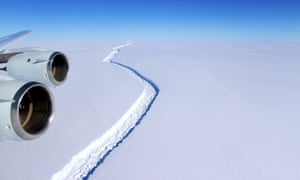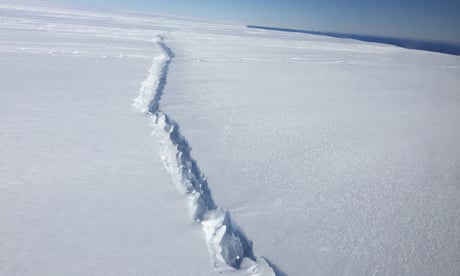Giant Antarctic iceberg 'hanging by a thread', say scientists
Split in the Larsen C ice shelf will release an iceberg a quarter of the size of Wales, changing the landscape of the Antarctic peninsula
 An aerial view of the Larsen C ice rift in Antarctica. The rift is now nearly 200km long, and will release an iceberg 5,000 sq km in size. Photograph: John Sonntag/AFP/Getty Images
An aerial view of the Larsen C ice rift in Antarctica. The rift is now nearly 200km long, and will release an iceberg 5,000 sq km in size. Photograph: John Sonntag/AFP/Getty ImagesView more sharing options
Shares
1,232
Nicola Davis
@NicolaKSDavis
Friday 2 June 2017 12.12 BSTLast modified on Friday 2 June 2017 17.50 BST
A giant section of an Antarctic ice shelf is hanging by a thread and could break off at any moment, researchers have revealed.
The split in the Larsen C ice shelf of the Antarctic peninsula will release a huge iceberg 5,000 sq km in size – an area about a quarter of the size of Wales.
“The rift is nearly 200km long now, and it has turned towards the ice front, suggesting that it has only got that last piece to go – and that last section is only 13km,” said Professor Adrian Luckman, a scientist at Swansea University and leader of the UK’s Midas project – an endeavour that has been monitoring the situation at the Larsen C ice shelf.
“Like any fracture in something, the longer the fracture becomes the more pressure there is on the remaining part of it. So it is really only hanging by a thread here,” he told the Guardian.
While the iceberg will not be the biggest ever recorded – the title is held by Iceberg B-15, a mass that broke off the Ross Ice Shelf in the year 2000 and had an area the size of Jamaica – it is expected to be among the top 10.
“It is a big event and it will change the landscape of the Antarctic peninsula - the Larsen ice shelf will be left 10% smaller,” said Luckman.
Analysis Antarctic ice sheet collapse will cause sea levels to rise. So what's new?
The results of our study might be surprising to some. But although it rules out very high rises, climate sceptics certainly shouldn’t be dancing in the aisles
Read more
The team have revealed that the latest images show that between 25 May and 31 May alone, the rift grew by 17km – the largest hike since the start of the year.
Luckman cautioned that it was not possible to say whether the fracture was a result of climate change.
“The rift has been there for decades; it might well have broken through at this moment, whatever had gone on. It could just be one of those cyclical factors in ice shelves – this is how they work, they grow and then they give birth to icebergs.”
Play Video
0:30 Aerial footage of the split in the Larsen C ice shelf taken at the start of the year.
But he pointed out that climate change “won’t have helped”, adding that the process has been linked to the breakdown of other ice shelves.
“The disintegration of Larsen A and Larsen B slightly to the north – it is widely accepted that they are climate-warming results,” he said.
“What happens to these ice shelves [of the Antarctic Peninsula] is in some ways a lesson for what might happen to the larger ice shelves that actually hold back ice from the main ice sheets – and that is potentially very significant into the far future,” Luckman added.

New studies show Rex Tillerson is wrong about climate risks
Read more
The latest update comes in the same week that US president Donald Trump announced that the US will be withdrawing from the Paris climate accord- an agreement signed in 2015 by more than 190 countries to tackle global warming.
With the next news from Larsen C – based on satellite data using radar imaging systems – not expected until Tuesday, the current state of the rift remains a tantalising mystery.
“It could be any time now, days or weeks – it could have gone already because we haven’t had an image of the area for the last two days. But it could still hang on for months because it is just very difficult to predict how ice will fracture, because we don’t know very much about this ice – it is quite remote” said Luckman. “My feeling is that it is going to go fairly soon.”
Since you’re here …
… we have a small favour to ask. More people are reading the Guardian than ever but advertising revenues across the media are falling fast. And unlike many news organisations, we haven’t put up a paywall – we want to keep our journalism as open as we can. So you can see why we need to ask for your help. The Guardian’s independent, investigative journalism takes a lot of time, money and hard work to produce. But we do it because we believe our perspective matters – because it might well be your perspective, too.
If everyone who reads our reporting, who likes it, helps to support it, our future would be much more secure.
Sem comentários:
Enviar um comentário